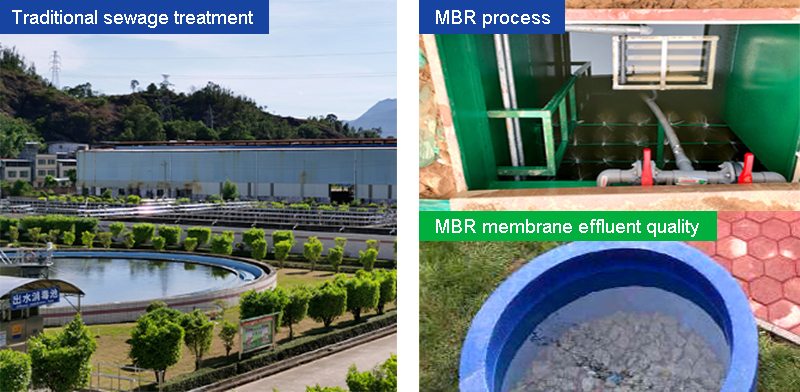MBR process (Membrane Bioreactor) is a new type of wastewater treatment process that combines traditional biological contact oxidation and ultrafiltration technology. The MBR process uses microporous or ultrafiltration membrane components as solid-liquid separation equipment. Through membrane filtration technology, the mixed liquid in the bioreactor is completely separated from the sludge, allowing the liquid to flow out of the pores of the membrane components. Microorganisms, suspended solids, colloids, and other macromolecular substances are trapped in the reactor, achieving efficient purification of wastewater.

Compared with traditional sewage treatment processes, MBR process has advantages such as stable effluent quality, small footprint, low operating cost, and simple operation. In practical applications, MBR technology is widely used in urban sewage treatment, wastewater treatment in the food and pharmaceutical industry, seawater desalination, oilfield wastewater treatment, and other fields.
1. The effluent quality is more stable and efficient, and can reach higher water quality standards
Traditional sewage treatment processes use sedimentation and biological reactions to treat wastewater, but this method has the problem of unstable effluent quality and difficulty in achieving high standards. In contrast, the MBR process adopts membrane filtration technology, which completely filters out suspended particles, biological cells, etc. in the wastewater, thereby ensuring the stability and efficiency of the effluent quality. At the same time, the MBR process can effectively remove organic compounds such as COD, BOD, NH3-N, and nutrients such as nitrogen and phosphorus, meeting current environmental requirements.
2. Large space utilization, saving land area
In traditional sewage treatment processes, a large number of sedimentation tanks and bioreactors are required, resulting in a larger system footprint. In the MBR process, a series of membrane components are used to replace traditional sedimentation and filtration equipment. These membrane components can achieve wastewater treatment in a small space, greatly improving the overall system space utilization and saving land occupation.
3. High resistance to load shock and stronger adaptability to instantaneous load fluctuations
Traditional sewage treatment processes often have drawbacks such as susceptibility to instantaneous load fluctuations and difficulty in ensuring effluent quality. The MBR process adopts membrane filtration technology, which allows microorganisms in the wastewater to stay in the reactor for a long time and not be discharged from the system due to instantaneous load fluctuations. This advantage can effectively improve the system's ability to withstand load shocks, while also enhancing the stability of the system's wastewater treatment effect.
4. Simple operation, high degree of automation, and convenient maintenance and management
Compared to traditional sewage treatment processes, the MBR process is simpler to operate as it is essentially automated. In addition, it also has functions such as remote monitoring and alarm, which can be centrally controlled and managed through a computer. These characteristics result in lower operating and maintenance costs for the MBR process, while also reducing the impact of manual operations on the stability of process operation.
Post time: Dec-25-2023

